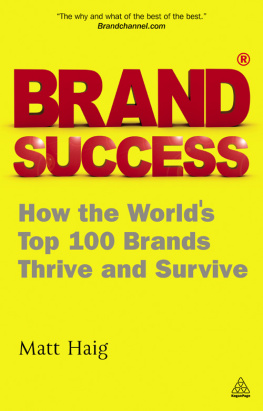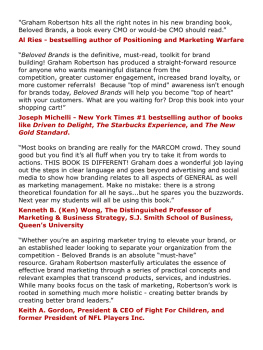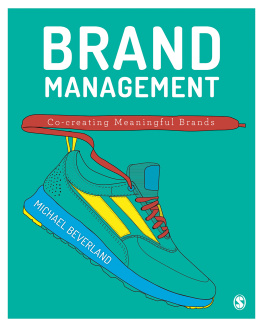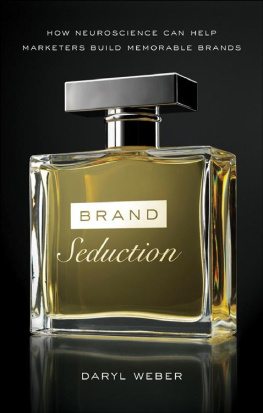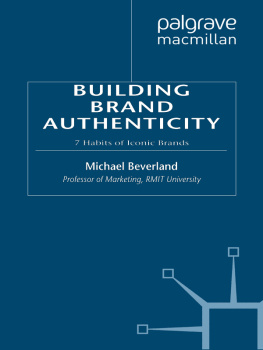
Table of Contents
A great book with insightful stories about how marketing managers develop romantic, deep, and personal relationships between the brand and the consumer.
Jagdish N. Sheth, Charles H. Kellstadt Professor of Marketing, Goizueta Business School, Emory University
Romancing the Brand shows that a brand's strength, and ultimately its ability to generate significant talk value, lies in creating a meaningful consumer experience. People talk aboutand advocate forbrands with which they have an emotional bond. Aided by entertaining stories about brands that have created love affairs with the consumer, Romancing the Brand is an essential guide for marketers who are looking to strengthen their consumer relationships.
Ed Keller, CEO, the Keller Fay Group, and coauthor, The Face-to-Face Book and The Influentials
Emotional, educational, and effective, Romancing the Brand captures the timeless fundamentals of marketing, using contemporary examples and a framework one can relate to in a primal way. Tim Halloran shares insights that up-and-coming marketers, as well as global executives at the top of their game, will find valuable.
Dick Patton, global chief marketing officer practice leader, Egon Zehnder
Cover design by Adrian Morgan
Cover image Shutterstock
Copyright 2014 by Tim Halloran. All rights reserved.
Published by Jossey-Bass
A Wiley Brand
One Montgomery Street, Suite 1200, San Francisco, CA 94104-4594www.josseybass.com
No part of this publication may be reproduced, stored in a retrieval system, or transmitted in any form or by any means, electronic, mechanical, photocopying, recording, scanning, or otherwise, except as permitted under Section 107 or 108 of the 1976 United States Copyright Act, without either the prior written permission of the publisher, or authorization through payment of the appropriate per-copy fee to the Copyright Clearance Center, Inc., 222 Rosewood Drive, Danvers, MA 01923, 978-750-8400, fax 978-646-8600, or on the Web at www.copyright.com. Requests to the publisher for permission should be addressed to the Permissions Department, John Wiley & Sons, Inc., 111 River Street, Hoboken, NJ 07030, 201-748-6011, fax 201-748-6008, or online at www.wiley.com/go/permissions.
Limit of Liability/Disclaimer of Warranty: While the publisher and author have used their best efforts in preparing this book, they make no representations or warranties with respect to the accuracy or completeness of the contents of this book and specifically disclaim any implied warranties of merchantability or fitness for a particular purpose. No warranty may be created or extended by sales representatives or written sales materials. The advice and strategies contained herein may not be suitable for your situation. You should consult with a professional where appropriate. Neither the publisher nor author shall be liable for any loss of profit or any other commercial damages, including but not limited to special, incidental, consequential, or other damages. Readers should be aware that Internet Web sites offered as citations and/or sources for further information may have changed or disappeared between the time this was written and when it is read.
Jossey-Bass books and products are available through most bookstores. To contact Jossey-Bass directly call our Customer Care Department within the U.S. at 800-956-7739, outside the U.S. at 317-572-3986, or fax 317-572-4002.
Wiley publishes in a variety of print and electronic formats and by print-on-demand. Some material included with standard print versions of this book may not be included in e-books or in print-on-demand. If this book refers to media such as a CD or DVD that is not included in the version you purchased, you may download this material at http://booksupport.wiley.com. For more information about Wiley products, visit www.wiley.com.
Cataloging-in-Publication data on file with the Library of Congress.
978-1-118-61128-9 (cloth); 978-1-118-82896-0 (ebk); 978-1-118-82897-7 (ebk)
To Nancy, the romance of my life
and to
Henry, Jane, and Lydia
Romance and the Brand
I had already been in the dark room for three-and-a-half hours, a bowl of peanut M&Ms in front of me, observing groups of women through a two-way mirror that felt like something out of CSI, as they explained their beverage consumption habits. Observing focus groups was a common practice for Coca-Cola brand managers. We were always striving to understand our consumers better so that we might find a way to connect with them. Our ultimate goal was to give folks like the women in this room a reason to purchase our brand rather than the hundreds of other options available to them.
I found myself wondering how much of what I did every daytrying to meet the needs of a finicky consumer base with some creative new message or compelling product improvementwas pointless. Did consumers really care about these brands? Looking around the observation room, I saw six or seven colleagues in various stages of engagement: among others, the assistant brand manager taking copious notes that would ultimately summarize our findings to our senior management, the agency account rep trying to infer something brilliant from a consumer's comment, and the marketing research manager making sure the moderator on the other side of the glass was covering everything on our checklist. All of us waiting, observing, listening for anything we could use in developing next year's marketing campaign. We needed to understand these women's thoughts and feelings about our brands in order to do our jobs.
But then something happened that subtly but profoundly changed my perception of how we as marketers should think about brands and the role they play in our consumers' lives.
It wasn't a particularly dramatic moment. The eight women sat around the overflowing table of colored cans and bottles of soft drinks. They had just completed what we call a sorting exercise, in which participants arranged soft drink brands in groups based on some organizing principle that they were to develop themselves. I don't remember how they organized the forty-plus brands that day, but what happened next stuck with me. A petite woman in her late twenties, picked up one of the cans and said to the focus group moderator, I drink eight of these a day. It is always with me, no matter what happens. It was there when my boss gave me my promotion last week. It was at my side two months ago when my cat died. It got me through it. I start and end my day with it. It's never lets me down. I can always count on it. To sum it up, it's my boyfriend Diet Coke.
My Beverage, My Boyfriend
A wave of laughter hit the room, so loud that I'm sure the respondents could hear us on the other side of the two-way mirror. I sat up. Did she really say that Diet Coke was her boyfriend? How could one think of a can of sugar water (actually aspartame water in this case) in boyfriend terms? Commitment, intimacy, dependabilityshe felt all of these, not about Diet Coke, but from it. She loved it as a constant companion, a support mechanism, a celebratory friend. This was preposterous, wasn't it? We can't connect with products the same way we connect with people!
But in some important ways, that is just what we do. Academic studies have proven it repeatedly. We don't just consume or interact with brands. We actually engage in relationships with them. With some brands, we have wild, short-term flings. Others stay with us for a lifetime, like family. Some brands offer us strictly utilitarian relationshipsthey are in our daily lives, yet we have no emotional connection to them. Maybe the brand feels like good medicine, like a physician, or maybe it's a loose connection, like a distant uncle you rarely see. Or maybe you rely on it, like a teacher, a coach, or even a parent. Each product and each consumerand each relationship between the twois different. But the young woman who so eloquently expressed her feelings about Diet Coke crystallized for me the simple truth that consumers engage in relationships with brands. If marketers were going to succeed, we would have to go beyond thinking about consumers as target markets that we needed to make aware of our brand and convince to purchase it. We needed to think about engaging consumers in a long-term relationship.



